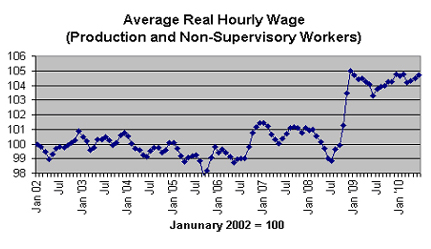August 11, 2010
David Leonhardt tells readers that the Great Recession has had some silver linings for many workers. High on his list is continued wage growth. This is misleading. All the real wage growth in this downturn occurred in the months of November and December of 2008. This was due to a plunge in the price of oil and other commodities. Since December of 2008 real wages have stagnated.
The wage growth in those two months also followed 6 years of wage stagnation. Essentially, nominal wage growth was eaten up by rising commodity prices during the upturn. These gains were then realized when prices crashed, but it is misleading to imply a pattern of consistent wage growth during the downturn.

The piece also correctly notes that unemployment has been concentrated among a smaller segment of the workforce than was true in the 1981-82 recession. This is a direct implication of the high levels of long-term unemployment. However, it is also worth noting that part of the reason that unemployment is more concentrated is that the workforce is much older today.
In the 1981-82 recession the baby boom cohort was between ages 17 and 36, years when workers change jobs frequently. At present, they are between the ages of 46 and 64, years in which workers infrequently change jobs. This means that much of the reason for the greater concentration of unemployment may be due to a change in the workforce rather than the demand side of the market.







Comments